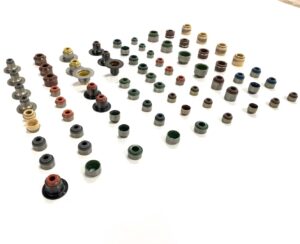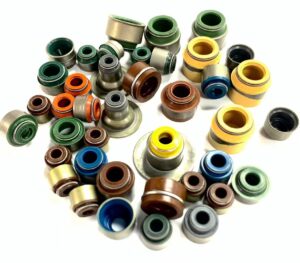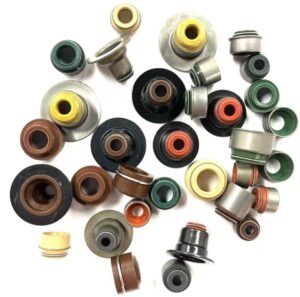Table of Contents
ToggleComprehensive Guide to Oil Seals: Applications, Installation, Replacement Costs, and Popular Models
Oil seals are essential components used in various applications to prevent oil leakage, protect against contaminants, and ensure the smooth operation of machinery and engines. From axle shaft oil seals to crankshaft oil seal replacements, the right oil seal helps to maintain system integrity and reduce downtime. In this article, we’ll dive into different types of oil seals, including valve stem oil seals, oil valve seals, and seal oils, exploring their applications, sizing, popular models, and cost considerations.



Oil Seal Installation: Ensuring Proper Fit and Function
Proper oil seal installation is crucial for preventing leaks and ensuring the effective functioning of mechanical systems. Incorrect installation can lead to premature wear, leaks, and costly repairs. The key steps in oil seal installation include:
- Cleaning the Surface: Ensure the sealing surface is free from dirt, debris, or any contaminants that might damage the seal.
- Lubrication: Lightly lubricate the seal’s lip with oil to reduce friction during installation.
- Proper Alignment: Install the seal squarely to avoid misalignment, which could lead to leaks or seal damage.
- Use the Right Tools: Use proper tools, such as a seal driver, to ensure even pressure during installation without damaging the seal.
Installation Tip: Always check the installation manual provided by the manufacturer to ensure proper techniques are used for specific seal types.
Oil Seal Manufacturers: Leading Players in the Industry
Several well-known oil seal manufacturers produce high-quality seals used in automotive, industrial, and hydraulic applications. Some of the leading manufacturers include:
- SKF: Known for producing reliable oil seals for a variety of applications, including automotive and industrial machinery.
- National Oil Seals: Provides a wide range of oil seals for both domestic and commercial vehicles, as well as machinery.
- Timken: Offers durable seals designed for automotive and industrial equipment.
- Freudenberg Sealing Technologies: Specializes in high-performance seals for demanding applications in automotive and industrial sectors.
These manufacturers provide various oil seal types, materials (rubber, polyurethane, and PTFE), and designs to meet the specific sealing needs of different industries.
Oil Seal Replacement Cost: Factors to Consider
The oil seal replacement cost can vary widely depending on the type of seal, the brand, the complexity of the installation, and the application. Here’s a rough breakdown of typical costs:
- Basic Crankshaft or Camshaft Oil Seal: $5 to $20 per unit, with labor costs for replacement ranging from $100 to $300 depending on the engine or machine complexity.
- Valve Stem Oil Seals: Typically cost $2 to $5 per seal, with a full replacement kit costing around $40 to $100.
- Axle Shaft Oil Seal: $10 to $40 depending on the vehicle and the manufacturer.
- Oil Pump Oil Seal: These can range from $5 to $15.
Factors like the labor required for installation, the difficulty of accessing the seal, and whether additional components (such as gaskets) need replacement, can increase the overall cost.
Oil Seal Size Chart PDF: Helping You Choose the Right Seal
Having an oil seal size chart PDF at hand is essential when selecting the right seal for a particular application. A typical oil seal size chart provides dimensions in the format: inner diameter (ID) x outer diameter (OD) x thickness (T). For example:
- Crankshaft Oil Seal: 50x70x10 or 55x75x10.
- Valve Stem Oil Seal: 10x15x8 or 12x18x10.
- Axle Shaft Oil Seal: 40x60x12 or 50x70x14.
Access to a size chart ensures you select the appropriate seal that matches the specific application, whether for automotive, industrial, or hydraulic machinery.
Oil Valve Seal: Preventing Oil Leaks in Engine Components
An oil valve seal is a crucial component in the engine that prevents oil from leaking into the combustion chamber. It maintains the oil pressure and ensures proper engine lubrication by preventing excessive oil consumption and smoke.
Common Applications:
- Automotive Engines: Valve oil seals are used to seal the area where the valve stem passes through the cylinder head.
- Motorcycles: Used in both motorcycle engines and valve systems.
Popular Models:
- SKF 10241: Known for preventing oil leaks and maintaining performance in valve systems.
- National 472117: A commonly used valve oil seal for automotive applications.
Cost: Valve oil seals typically range from $1 to $3 per unit.
Seal Oil: What Is It and Its Benefits?
Seal oil is used in certain industrial applications, particularly in machinery and equipment where it provides lubrication and prevents leaks in sealed systems. It is typically used to reduce friction and wear, ensuring the longevity and efficient operation of mechanical components.
Benefits of Seal Oil:
- Reduces Friction: Helps minimize wear and tear on mechanical parts.
- Prevents Leakage: Keeps oil and fluids sealed in machinery, reducing the chances of leaks.
- Enhances Performance: Increases the lifespan of seals, bearings, and other mechanical components.
Common Uses:
- Industrial Machinery: Often used in high-speed rotating machinery like turbines and compressors.
- Automotive Engines: Used in certain components like turbochargers to reduce friction.
Seal Oil Cooler: Temperature Control for Sealing Systems
A seal oil cooler is used to regulate the temperature of the oil that is circulating within sealed systems, such as those in large industrial machinery. These coolers prevent the oil from overheating, which could otherwise cause the seals to degrade or lose efficiency.
Common Applications:
- Marine Engines: Helps regulate oil temperature in turbochargers and other sealed systems.
- Industrial Equipment: Used in compressors and hydraulic systems to maintain oil at optimal temperatures.
Cost: Seal oil coolers can range from $100 to $500 depending on the application and the cooling capacity required.
Seal Oil Filter: Preventing Contaminants in Sealed Systems
A seal oil filter is used to remove contaminants from the oil circulating in sealed systems. It ensures that the oil remains clean and free of debris, which could damage seals or other critical components.
Applications:
- Hydraulic Systems: Protects seals and pumps from contaminants in hydraulic fluid.
- Engines: Ensures clean oil circulation to prevent wear and leakage.
Cost: Seal oil filters typically cost between $5 to $30, depending on the type and application.
Valve Stem Oil Seal: Key to Engine Performance
A valve stem oil seal is designed to prevent oil from leaking past the valve stem and into the combustion chamber. These seals are critical in preventing excessive oil consumption and maintaining engine performance.
Common Applications:
- Automotive Engines: Prevents oil leakage in the valve stem area, ensuring smooth valve operation.
- Motorcycles and Small Engines: Used to seal oil within the engine and reduce emissions.
Popular Models:
- National 472015: A commonly used valve stem oil seal in automotive engines.
- SKF 22878: A durable valve stem seal for motorcycles and light engines.
Cost: Valve stem oil seals are generally priced between $2 to $5 per seal, with kits ranging from $20 to $50.
Crankshaft Oil Seal Replacement: Ensuring Long-Lasting Engine Sealing
The crankshaft oil seal is located where the crankshaft exits the engine block. This seal is crucial for maintaining oil pressure and preventing oil leaks, which can lead to engine damage if not replaced in a timely manner.
Common Applications:
- Automobile Engines: Seals the crankshaft to prevent oil leaks.
- Heavy Machinery: Used in large engines to maintain oil integrity and pressure.
Popular Models:
- SKF 24188: A reliable crankshaft oil seal used in various automotive and industrial applications.
- National 471742: Frequently used for both front and rear crankshaft sealing.
Cost: Crankshaft oil seal replacements typically range from $5 to $20, with labor costs adding $100 to $300 depending on engine complexity.
Front Crank Oil Seal: Preventing Oil Leaks in High-Torque Engines
The front crank oil seal is located at the front of the crankshaft, often sealing around the timing gear or pulley. This component is critical for preventing oil leaks in high-torque engines where maintaining oil pressure is vital for performance.
Applications:
- Automotive Engines: Used in engines to seal the crankshaft at the front end.
- Heavy-Duty Vehicles: Prevents oil leaks in trucks, buses, and other large vehicles.
Popular Models:
- Timken CR-22543: A high-quality front crankshaft seal for heavy-duty applications.
- SKF 24242: A durable front crank seal widely used in automotive engines.
Cost: Front crank oil seals generally cost between $5 to $10, with labor for replacement ranging from $150 to $400.
Conclusion: Meeting Market Demands with the Right Oil Seals
Oil seals are vital in maintaining engine performance, preventing leaks, and ensuring the longevity of machinery and vehicles. Whether you need to replace a valve stem oil seal, install a crankshaft oil seal, or upgrade a seal oil filter, choosing the right seal for your application is essential. By understanding the installation process, popular models, and cost factors, you can make informed decisions to keep your equipment running smoothly and efficiently.



Leave A Comment